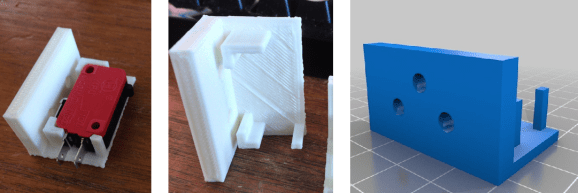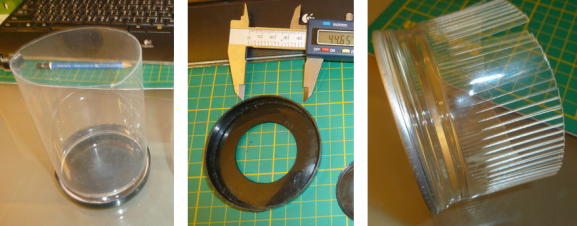
Not long ago the Shapeoko 2 came out. In case you missed it, the Shapeoko 2 is the 2nd generation bench-top CNC Router of the namesake. All axes roll on Makerslide and v-wheels. The X and Y axes are belt driven, power is transmitted to the Z axis by lead screw.
As with most products, there will be people who must hack, mod or upgrade their as-received item. If you are a regular Hackaday reader, you are probably one of those people. And as one of those people, you would expect there have been a few individuals that have not left this machine alone.
CNC Machines are dumb, they do what you tell them. Sometimes us humans ask them to do things that result in the machine trying to travel past its physical limits. To protect his machine from human error, [Zorlack] decided to make limit switch brackets for his Shapeoko. They are 3D printed, accept standard limit switches and bolt directly onto the Makerslide rails of the machine. These types of switches are used as travel limits, where if triggered, the machine stops moving in that direction. If you’d like a set, they are available for download at the above link.

We’ve discussed recently how much dust a CNC Router creates and how to manage that dust on the cheap. [Jason] blew away the ‘on the cheap’ record with this Dust Shoe for his Shapeoko. It is made only from an old tennis ball can. The lid is removed and a hole is cut in it just a bit smaller than the outer diameter of the router. The lid is then press-fit onto the router. Next, the plastic portion of the can is trimmed to length and slits are cut into the plastic to create flaps similar to brush bristles. These flaps were straight when cut but [Jason] used some heat to create a permanent outward curve. The newly created skirt snaps into the lid previously installed on the router and can be removed easily for tool bit changes. We’d like to see the next version have an outlet for a vacuum to collect the contained dust.
















Sweet. I was going to buy one as soon as I sell my rust bucket
I never found limit switches particularly useful. I mean, LinuxCNC (and hopefully other controllers) will simply refuse to run a program which exceeds machine limits.
Home switches, on the other hand, are, making sure that hardware and software are in agreement about where those limits are.
Am I missing something?
If you’re going to add home switches at one end of each axis, you might as well add limits at the other end. You shouldn’t need them if everything is working as expected, but all it would take would be some missed steps whilst travelling in a negative direction and you could easily exceed software machine limits.
Having said that, I *still* haven’t got round to adding home or limit switches to my own CNC converted mill.
True, though I wouldn’t add them into the software. I’d make them shut off the power to the machine as a hardware safety.
Limit switches can prevent potential damage from going over the edge if an error accumulates over a long run. One would hope that this never happens. Home switches make it less likely to happen, since they ensure that at the beginning of a run the hardware and software are in agreement, but they do not prevent it from happening in a pathological case — say, a single piece that is continuously milled over a period of three weeks, wherein the machine doesn’t re-home itself until long after some one-tenth-of-one-percent error has snowballed into a total of tens of centimeters.
Were I to do it, I’d have both. A couple dollars spent on limit switches and a hit to the ego (admitting that it’s possible that the machine could overrun its limits, even though it’s been homed at the start of the run) is a lot cheaper than replacing burnt-out steppers.
“A hit to the ego” :D
This makes sense, thanks for the explanation.
+1 on using LinuxCNC, limit switches really seem unnecessary for machine with trivial kinematics, if it is configured properly and correct soft limits are defined. OTOH many people use such switches for both – limits and homing, so it is just a matter of attaching something to trip the switch on the opposite-to-home side of travel.
just to make clear – I meant using one switch per joint for both limits and home…
The machine only knows where the head is located during the homing operation.
Although unlikely, it could be possible that a loose belt slips in one direction but not the other, causing it to be out of position.
There are also a whole bunch of human related errors that could come into play.
Consider them insurance – a (very) little cost/effort up front to save you from possible catastrophe later.
One one level, you are correct in that limit switches aren’t required for operation of a machine, and this is a function generally better handled by software for the every day case.
However they do provide additional insurance against operator error (jogging into hard stops), misconfiguration of those machine soft limits during integration, etc.
One benefit on stepper driven systems is that when you hit a limit switch, the software should not allow you to travel any further in that direction so that there is less risk of losing steps when jogging manually saving you the need to re-home again after realizing you’ve gone too far.
The actual requirement for limit switches is dictated by the potential damage that could be caused by running in to a hard stop even at low speed (at high speed limit switches often do not help and depending on the style can get damaged anyways).
@whitequark, Shapeoko doesn’t come with home or limit switches. You can add limit switches yourself and have them double up as home ones.
If your switches have holes, you can also mount them directly to the motor plates using the small slot on each side and it doesn’t require any 3d printing. They will line up with an M5 sized hole on the end plates, which using a spare M5 bolt and nut can make a nice adjustable stopper. This is what I’ve done on my Shapeoko 2.
What switches did you end up using?
The ones from Inventables
I still haven’t installed home or limit switches on my gantry CNC. Its on my todo list but seems like there is always another project to do first. I have both steppers and servo motors (Z axis) on my gantry. Your not going to kill a stepper motor by running into a hard stop. The stepper motor will just loose steps. I’ve done that many of times by rapid jogging at 300IPM in the wrong direction with the keyboard. You can potentially harm a servo motor by running into a hard stop. The servo motor driver will try to increase current and move the servo until a encoder following error or peak current limit has been reached. The driver at that point will shutdown with a error. Hopefully the driver will shutdown before the servo motor heats up and destroys itself. Its not likely to happen but a servo is a whole lot more expensive to replace than a $40 nema23 stepper motor. With that in mind I really need to install those switches that I have in the drawer…..
Think of them as an automatic emergency stop. If you leave your CNC running for hours unattended, they give you peace of mind. Well worth a couple of dollars each.
I would think that home switches would help you zero a piece easier for two sided cutting.